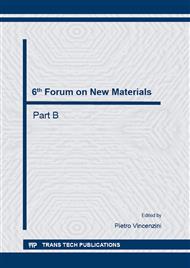p.69
p.75
p.85
p.93
p.97
p.103
p.111
p.115
p.121
A New Matrix for Conditioning Chloride Salt Wastes from the Electrorefining of Spent Nuclear Fuel
Abstract:
A novel method proposed by Korea Atomic Energy Research Institute has been applied to the treatment of chloride salt wastes coming from electrorefining of spent nuclear fuel, which allows to separate uranium from fission products. It is based on a matrix, SAP (SiO2-Al2O3-P2O5), synthesized by a conventional sol-gel process, able to stabilize the volatile salt wastes due to the formation of metalaluminosilicates, metalaluminophosphates and metalphosphates. With this method a higher disposal efficiency and a lower waste volume can be obtained. Eutectic melt LiCl-KCl (59-41 mol%) has been used to simulate the waste salt. The composite SAP has been prepared by using tetraethyl ortosilicate (TEOS), aluminum chloride (AlCl3.6H2O) and phosphoric acid (H3PO4) as sources of Si, Al, and P, respectively. All reagents were dissolved in EtOH/H2O and the mixture, tightly sealed, was placed in an electric oven at 70 C. After a gelling/ageing for 3 days, the transparent hydrogels were dried at 110 C for 3 days and then thermally treated at 600 C for 2 hours. The final product (SAP) was reacted with metal chlorides at increasing temperatures for 20 hours inside an Argon-atmosphere glove-box, after mixing them at a SAP/metal chloride mixing ratio of 2. The obtained products have been characterized by means of density measurements, scanning electron microscopy, thermal analysis, as well as by XRD, FTIR and Raman spectra. Financial support from the Nuclear Fission Safety Program of the European Union (project SACSESS, contract FP7-CP-2012-323282) is gratefully acknowledged.
Info:
Periodical:
Pages:
97-102
Citation:
Online since:
October 2014
Price:
Сopyright:
© 2014 Trans Tech Publications Ltd. All Rights Reserved
Share:
Citation:


